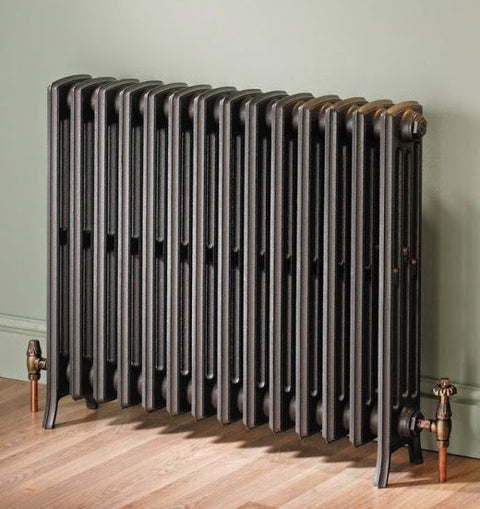Steel vs Plastic Baseboard Heater Covers (or vs. Wood Covers)

When you think of a traditional radiator, what comes to mind? If it's a big, clunky cast iron radiator taking up space against a wall, you're not alone. Cast iron radiators are the original hot water heating system in North America.
Built to last forever, millions of them are still in perfect working condition. You might wonder, with all the technological advancements in heating, is there a better way? Would baseboard heat be just as effective with plastic or wood baseboard heater covers?
Metal is an important element to the success of baseboard heating. It's all about the conductivity and retention of heat energy.

Why Steel vs Wood Baseboard Heater Covers (or Plastic Heater Covers)
Finned tube element heating, also known as baseboard heating, uses the exact same convection and radiant heating principles as radiators. When more warmth is needed, the boiler turns on and heated water flows through to the emitters in the heating loop.
Air currents in the room are heated when they come in contact with the fins. The warm air will rise and then eventually cool and fall to the floor. This process is cyclical. What happens when the thermostat tells the boiler to shut down after the set temperature has been reached?
The water in the system stops flowing and eventually cools. It is at this stage of the cycle where the presence of steel close to the emitter makes a huge difference.
Steel is an excellent conductor of heat energy. Wood and plastic are not. After the boiler shuts off, the steel baseboard heater covers will still retain warmth. The room's air currents will continue to circulate for a certain period of time until the temperature in the room drops.
Because it retains and radiates heat, steel reduces the consumption of fuel and boosts efficiency. It's the clear winner when compared to materials like plastic or wood.

Steel vs Plastic vs Wood as a Conductor
The quantity of heat transmitted through a material is called thermal conductivity. It's a way heating efficiency can be measured for baseboard heating. Thermal conductivity units are expressed as the amount of energy in Watts per meter Kelvin.
Most species of wood: 0.15 W/(m K)
Polymer plastics: 0.25 W/(m K)
Carbon Steel (iron): 43.0 W/(m K)
The values above make a clear case for using steel or any other material with significant thermal conductivity attributes. It also demonstrates why the big old cast iron radiators have always been made the way they were.
Of course there are other reasons why insulating materials like wood and plastic should be avoided for baseboard heater covers. In the case of wood, it is a natural product that contains moisture. Any wood that is exposed to constant heat (as a wood baseboard heater cover would be) will eventually crack. This includes man-made fiberboard.
Plastic baseboard heater covers, assuming they don't melt, will offer a low retail price point - but be careful. When you use a material like plastic or wood over your baseboard heater, it might impact efficiency. That low-cost purchase might actually cost you a few extra dollars in day-to-day use in the long run.
Wood Baseboard Heater Covers Over Metal
It's common to see finely crafted wood radiator enclosures that dress up the old style radiators. These wood enclosures are installed purely for aesthetics. They do not hold or radiate any heat and may impede heating efficiency.
Baseboarders have been designed around the traditional role of using significant amounts of heat-hungry steel around finned tube element. We use heavy duty steel between 18 and 24 gauge thickness. This generous amount of material offers the right combination of durability, structural integrity, heat retention and aesthetic beauty.
Take a Closer Look at Baseboarders®
